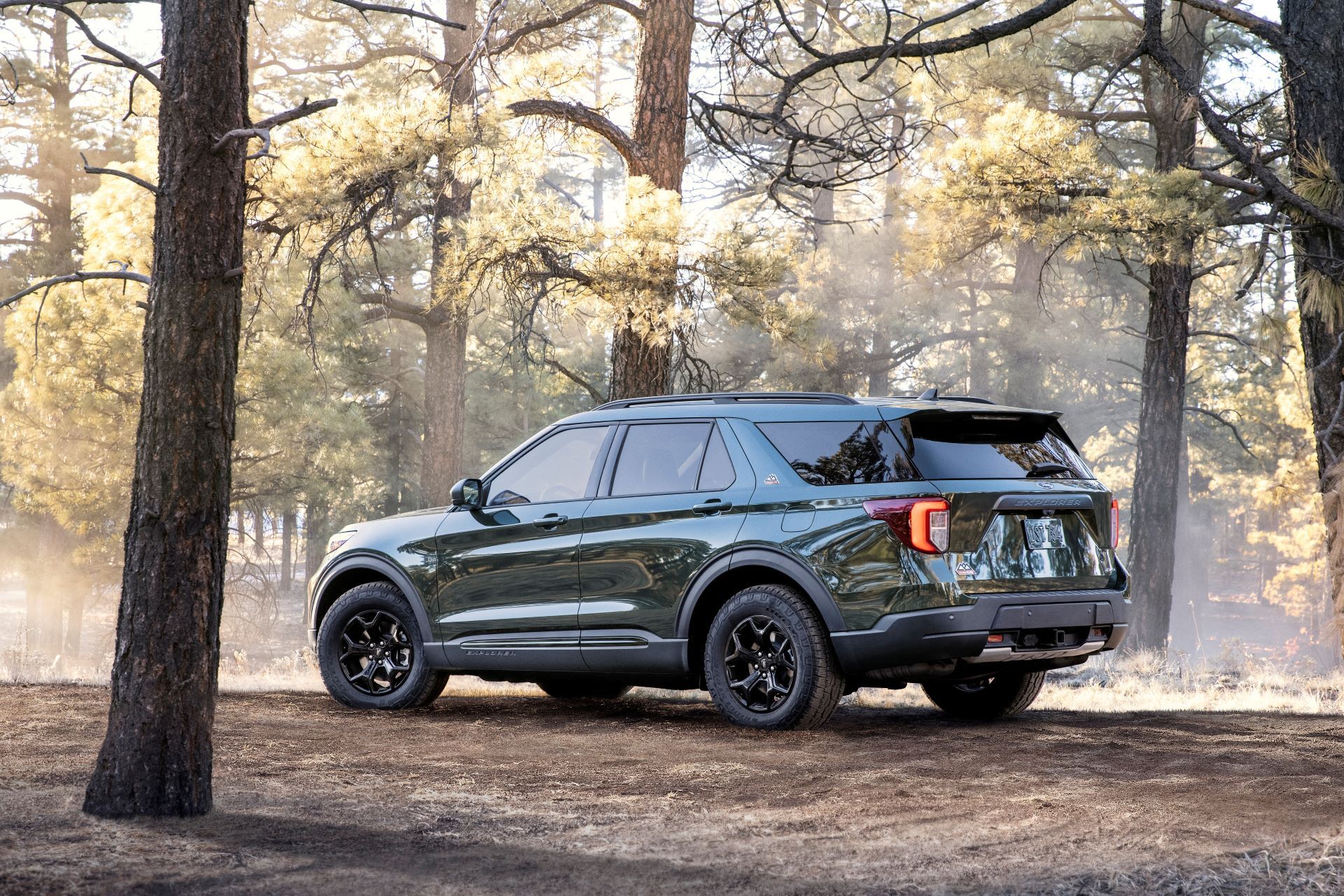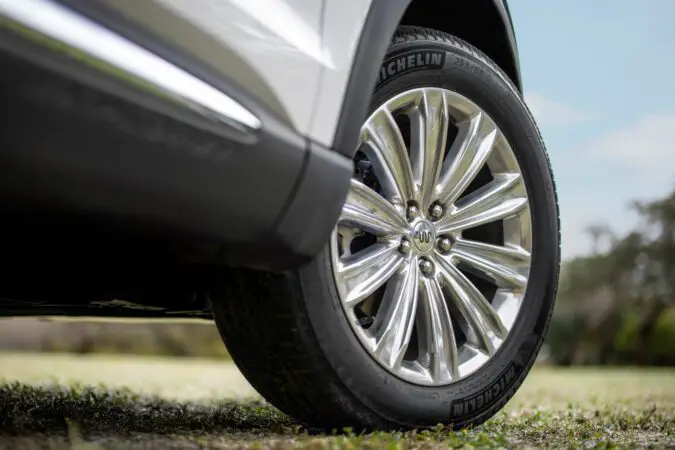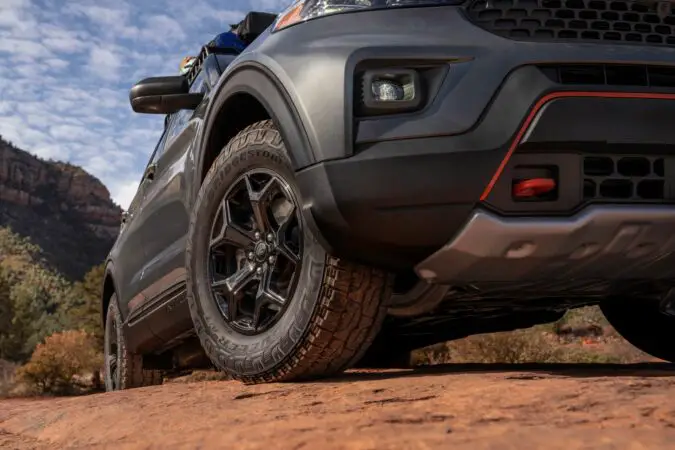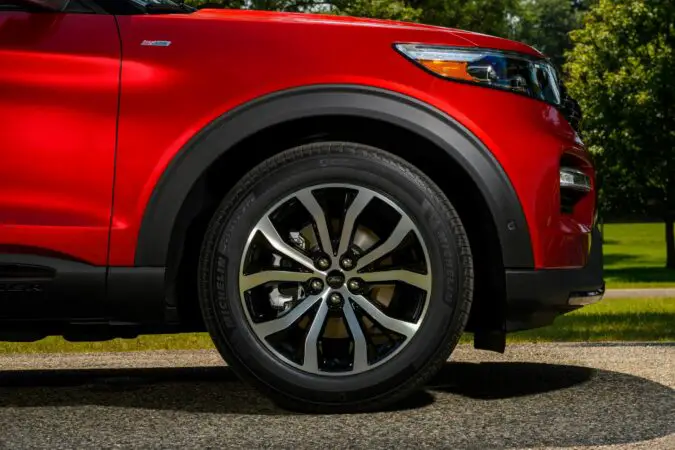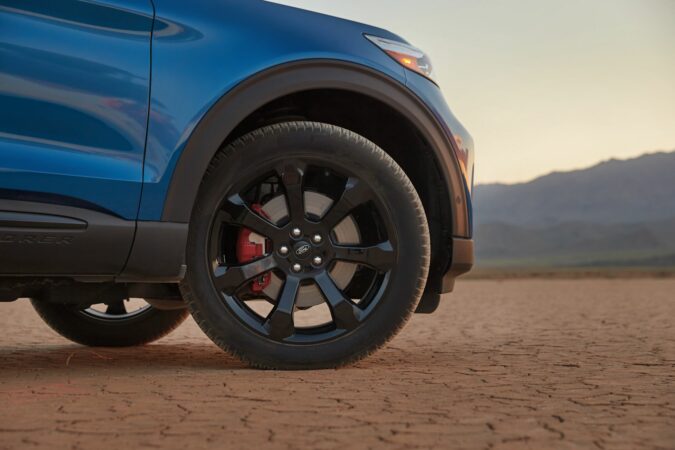Don’t worry if you didn’t give the bolt pattern for Ford Explorer much thought when you bought it; most drivers aren’t familiar with their vehicle’s bolt pattern off the top of their heads.
But if you ever wish to replace the stock wheels on your Explorer, being aware of the bolt pattern is crucial. We’ll discuss the knowledge you need to have in order to choose the ideal replacement tires or rims for your Explorer today.
It doesn’t matter if it’s a Ford Explorer ST, or just any old Explorer, it’s crucial to figure out the exact bolt pattern specs. We’ll focus on the bolt pattern for Ford Explorer in particular.
Ford Explorer Wheels
Replacement wheels for a Ford Explorer typically cost between $530 and $550. So, that should answer any questions on how much are car rims.
If you’re thinking of adding a bit of bling to your Explorer, you might even consider powder-coated rims, dip your rims in chrome, or think about how much do black rims cost.
While parts are priced at $478, based on the data that we’ve scoured, labor costs are predicted to range between $44 and $56.
Taxes as well as any other fees are not in this range, and neither are geographic area or the particular model year taken into consideration. There might be a need for more repairs.
The number and age of Ford Explorers on the road are the basis for this group.
Bolt Pattern For Ford Explorer, Facts #1 – How Do Wheels Work
The car tires help to put it on a stable platform provided by their wheels.
They are built of durable materials, ranging from steel to magnesium, and are designed to withstand several impacts from the road during their useful lives. This makes sense since it is the wheels of the car that are subjected to the most beating compared to the other parts of the car.
They provide a firm surface that can be dependably operated upon by accelerating and braking force and are attached to the vehicle via the wheel hub lug studs or wheel nuts. Oh, and if you have aluminum wheels, do check out our guide on the best aluminum wheel cleaner to keep your wheels looking shiny.
Bolt Pattern For Ford Explorer, Facts #2 – What Signs Would Point To A Problematic Wheel
Even while this is the case the car wheels are simple. This subsequently means that they have very few symptoms. That said it is never a good idea to disregard them.
As soon as you notice something isn’t quite right with your car wheels it’s paramount that you address the issue ASAP.
Especially after hitting a big bump, the wheels may start to show visible cracks. Usually, this is accompanied by the tire on that wheel losing air. If for instance, you ignored this issue, it would only get worse and cause other issues. An example is a damaged suspension system (thus requiring expensive suspension repair costs).
Additionally, when the tire is out of balance, the steering wheel may frequently vibrate, and bad wheel nuts or bolts might result in cracking and popping sounds. This might be why your steering wheel shakes at low speeds, or if the steering wheel shakes when braking downhill.
Even though there are not many symptoms, they should not be disregarded.
Bolt Pattern For Ford Explorer, Facts #3 – Am I Able To Drive On A Damaged Wheel
You cannot delay a faulty wheel. When a wheel is fractured, bent, or otherwise unfit for use, it poses a safety hazard and needs to be replaced. While a rim scratch repair might be fairly simple, the cost and complexity to repair a bent rim aren’t so straightforward.
You can allow the wheel to go on the wheel hub if there is cracking or popping coming from the wheel nuts or wheel bolts, which need to be changed right away.
Finally, while unbalanced wheels do not pose a threat to safety, they will make driving much more comfortable.
Bolt Pattern For Ford Explorer, Facts #4 – How Frequently Do Wheels Need To Be Replaced
Damage, as well as aesthetic appeal, are the two main reasons for replacing wheels. There isn’t a single other justification for replacing a wheel.
Typically, following a collision or hitting a pothole, wheels are replaced. Avoid driving at speeds that impair reaction time and steer clear of potholes to prevent premature replacement.
Bolt Pattern For Ford Explorer, Facts #5 – How Are Wheel Problems Identified
The damage is typically visible to the naked eye when a wheel is failing.
By spraying a solution on the wheel and looking for bubbles, you may identify a crack that permits the tire to leak. We otherwise refer to those as a slow leak in the tire.
You cannot balance some wheels, despite seeming to be straight and true, using a high-speed or road-force balancing machine.
Bolt Pattern For Ford Explorer, Facts #6 – How Do Wheels Get Changed
You must elevate the car to remove the wheel from the vehicle by removing the wheel nuts or bolts when a wheel needs replacing.
To deflate the tire, you must take off the tire valve stem and Schrader valve.
You will then break the seal between the tire and the wheel by crushing the tire on both sides, and then remove the tire while the wheel is moving.
The replacement tire rolls onto the wheel after greasing the new wheel and you manually press down on the new tire.
Before a new Schrader valve is screwed into the new valve stem and the tire is aired to the appropriate pressure, high-pressure air is blown into the tire.
The mechanic will then mount the wheel and tire combination, balance it, and torque it in accordance with requirements before putting the vehicle through its paces.
Bolt Pattern Ford Explorer
This fundamental formula is the most straightforward method to look at bolt patterns for individuals who are unfamiliar with them: number of bolts x diameters of the resulting circle.
Every vehicle’s bolt pattern including the bolt pattern for Ford Explorer is assessed using this method.
Therefore, the 5×4.5 bolt pattern for Ford Explorer signifies that there are five bolts organized in a circular pattern on each wheel. That circle’s circumference is 4.5 inches.
Now that you understand that, let’s discuss some other phrases relating to wheels.
If you want to switch out the wheels, one of the many numbers you need to become familiar with is your vehicle’s bolt pattern.
You must also understand the stud size, offset, center bore, and torque requirements.
The bolt pattern for Ford Explorer is 54.5 inches across all models (114.3mm).
Ford Explorers manufactured in 2020 (do check out our write-up if you want to know if this is one of the Ford Explorer model years to avoid) and later feature a center bore of 2.77 inches (70.3mm) and five lug nuts with an M14 x 1.5 thread size that requires 150lb-ft (204Nm) of torque to tighten.
The five M12 x 1.5-threaded lug nuts on Explorers manufactured between 2012 and 2019 have a center bore of 2.49 inches (63.4 mm) and require 100 lb-ft (135 Nm) of torque to tighten.
The five M12 x 1.5-threaded lug nuts on Explorers manufactured between 1992 and 2010 have a center bore of 2.78 inches (70.5mm) and require 100 lb-ft (135 Nm) of torque to tighten.
That, however, hardly captures the entire picture.
We also go through the individual lugs/bolts used, the center bore hub’s exact diameter, and the bolt torque requirements.
Bolt Pattern For Ford Explorer – Specifications For Wheel Fitment By Generation
You’ll need to be aware of more details than simply the bolt pattern for Ford Explorer in order to properly install a wheel on your Explorer.
For each version of the Explorer (while we’re here, do check out our review on how long do Ford Explorers last), we’ve listed all the things you need to be aware of in the table below.
These are center bore diameter, use of bolts versus lug nuts, wheel tightening torque, as well as bolt thread size.
Let’s be clear that the specs given below apply to all models produced during that generation.
Indeed, you can find various trim levels as well as engine choices that come with the Explorer. However, within a generation, these lug specs, bolt patterns, and bolt patterns do not alter.
Bolt Pattern For Ford Explorer – Tire And Rim Sizes For Each Generation
In order to give you a clear picture of the tires you may and cannot buy, there is also a list of the precise tire and rim sizes utilized with each engine option.
The standard tire size for the 4.0L V6-powered 1990–1992 Ford Explorer is either 225/70R15 or 235/75R15, and the usual rim size is 7Jx15 ET30.
Standard tire sizes for 1993–1994 Ford Explorers with 4.0L V6 engines are 225/70R15 or 235/75R15, and standard rim sizes are 7Jx15 ET30.
The standard tire size for the 1995-2001 Ford Explorer with a 4.0i V6 or 5.0i V8 engine is 225/70R15 or 235/75R15, and the normal rim size is 7Jx15 ET12.
Standard tire sizes for the 4.0i V6 or 4.6i V8-powered 2002–2005 Ford Explorer are 235/70R16, 235/70R16, or 245/65R17. Standard rim sizes are 6.5Jx16 ET47, 7Jx16 ET44, or 7.5Jx17 ET44.
A tire with standard size of 235/65R18, 245/65R17, 235/70R16, or 235/70R16, and a standard rim size of 6.5Jx16 ET47, 7.5Jx17 ET44, 7.5Jx18 ET44 or 7Jx16 ET44, can be found on the 2006–2010 Ford Explorer with a 4.0i V6 or 4.6i V8 engine.
The standard tire size for the 2.0 EcoBoost I4 or 3.5Ti V6-powered Ford Explorer from 2011 to 2015 is 245/65R17, and the standard rim size is either 7.5Jx17 ET44, 8Jx18 ET44, or 8.5Jx20 ET44.
The standard tire size for the 2016–2017 Ford Explorer with a 2.3 EcoBoost I4 or 3.5 EcoBoost V6 engine is 255/50R20, while the standard rim size is 8.5Jx20 ET44.
Bolt Pattern For Ford Explorer – Normal Tire Size
Normal tire sizes for Ford Explorers powered by the 3.5Ti V6 engines are 245/60R18 or 255/50R20, and standard rim sizes are 8Jx18 ET44 or 8.5Jx20 ET44.
The standard tire size for the 2018–2019 Ford Explorer with a 2.3 EcoBoost I4 or 3.5 EcoBoost V6 engine is 255/50R20, while the standard rim size is 8.5Jx20 ET44.
Normal tire sizes for Ford Explorers powered by 3.5Ti V6 engines are 245/60R18 or 255/50R20, and standard rim sizes are 8Jx18 ET44 or 8.5Jx20 ET44.
Standard tire sizes for the 2020–2022 Ford Explorer with a 2.3 EcoBoost I4 engine are 255/65R18 or 255/55R20, and standard rim sizes are 7.5Jx18 ET37.5 or 8Jx20 ET37.
- The standard tire size for the Ford Explorer with a 3.0 EcoBoost V6 (365hp) or 3.3H (hybrid) V6 engine is 255/55R20, and the standard rim size is 8Jx20 ET37.
- The standard tire size for the 3.0 EcoBoost V6 (400 hp) Ford Explorer is 255/55R20, and the usual rim size is 8.5Jx20 ET40.
If you’re curious to learn more about this, do check out our guide on how to read your rim size, as well as our tire size chart by your side for easier reference.
Bolt Pattern For Ford Explorer – Retightening In The Bolts
As previously stated, the Explorer typically has five lug nuts. You must fasten these in precisely whenever you put back the wheel to the car.
Even while the owner’s handbook or auto repair manuals will contain the information, you can still find the instructions here. According to Ford, you should fasten these nuts in the manner depicted below. You must go in a crisscross fashion.
Bolt Pattern For Ford Explorer – Five-Bolt Design
You should tighten all of the nuts with a wheel wrench.
Please take care to only tighten them halfway; otherwise, problems may occur. Speaking of problems, we have an entire guide on the common Ford Explorer problems, if your Explorer is having trouble.
Using the wheel wrench, tighten them to the required lbs-ft or Nm during the second cycle.
Please note that you must tighten the bolt to 150 ft-lb for the current generation of Explorer.
Additionally, your wheel ought to have a center cap or cover. You must use the same design to secure them together. Please tighten them firmly using your hands.
Then, using the wheel wrench, tighten them one more quarter turn.
After 30 miles, it’s also crucial to make that the lug nuts are still in place (48 miles). Please make sure they are all there and still securely fastened.
If not, tighten them again and recheck. If this keeps up, the wheel will need replacing.
Bolt Pattern For Ford Explorer – When Ought My Tires To Be Rotated Or Replaced
Let’s say your tire needs replacing. Furthermore, you must precisely time when to rotate or replace it. Let’s start by talking about replacing your tires.
The average tire lifespan is 4-5 years or 60,000-75,000 miles. You must replace them when this period lapses.
Because this might occasionally happen early, it’s a good idea to pay attention to the tread wear indicators.
When the tread on your tires has worn down to barely 1.6 mm (1/16 in), these indicators will let you know.
You must take off your wheels and tires in order to rotate your tires. According to the owner’s manual for the Explorer, you need to do this every 7,500 miles.
It is a good idea that you rotate the tires. The front tires alternate between moving forward and moving across to the front.
If you’re like to learn more, feel free to head over to our extensive write-up on the cost of a tire rotation.
Bolt Pattern Measurement
Knowing the bolt pattern for Ford Explorer is one of the most important fitment considerations when purchasing wheels.
If so, there are some measurements that you’ll need to make. There are two methods to do this on a car with five lugs (with a few explanations for each), and just one way on a vehicle with four, six, or eight lugs.
Let’s look at the instructions for measuring using both techniques.
Let’s start with five-lug automobiles. Most are familiar with the measurement technique that involves measuring from the center of one stud to the outside of the third stud (skip a stud).
You can obtain the bolt pattern using this method directly. This is because the measurement you obtain corresponds to the bolt pattern for Ford Explorer.
The rear wheel is typically the easiest to measure because the hub won’t typically be in the way. Remove the current wheel.
How To Measure
Measure the distance between the outside of one stud and the middle of the next (skipping a stud).
The figure you see will represent the bolt pattern’s real size. As a result, if you observe 4 1/2 inches, your bolt pattern is 5 on 4 1/2 ( 54.5 and 5114.3). The 54.75 and 55 bolt designs are two more popular ones.
If your vehicle has a bolt pattern other than a 5-lug (i.e., a 4-lug, 6-lug, or 8-lug), you should measure it as follows:
The rear wheel is typically the easiest to measure because the hub won’t typically be in the way. Remove the current wheel.
Utilize a ruler or tape measure with a 32nds-of-an-inch resolution.
For 4-lug and 6-lug uses, measure between the inside of one stud and the outside of the adjacent stud; for a 5-lug usage, measure between the two studs that are close to one another.
The P.C.D
The P.C.D. (pitch circle diameter) or bolt pattern diameter will be the dimension you get when measuring a 4-lug or 6-lug.
4.5 inches will result in a 4X4.5 bolt pattern (four on four and a half).
Try measuring the distance in millimeters. If your measurement does not result in a whole, half, or quarter inch.
Use the measured distance when measuring a 5 lug, then consult the “5 Lug P.C.D. Chart.” The “Actual Dimension” will be on the chart as a three-place decimal.
Additionally, the chart displays measurements down to the “Nearest 32nd of an inch.” Find your measurement on the chart, and that will show you what your 5-lug vehicle’s bolt pattern is.
It is a good idea that you inspect the front and back. This is to make sure the bolt pattern for Ford Explorer matches in addition to the specifications mentioned.
As it might be simple to make a mistake when attempting to measure from the center of a stud by automobile owners measuring their 5-lug vehicle both ways.
Keep in mind that most wheel manufacturers, won’t accept returned wheels with a tire installed on them! Make sure the wheels fit your car before mounting the tires by performing a fit check.
Tire Size For Ford Explorer
The Ford Explorer is versatile and will perform well in all kinds of adventures, from cross-country travel to thrilling off-roading.
Your tires, however, suffer quite a bit from all the driving.
Ford tires will survive for many years, but eventually, you’ll need to replace them.
You must have the correct tire size for your SUV in order for it to function effectively and safely, regardless of whether you require an improved set, a new set for the winter, or you’ve had a blowout.
Ford Explorer Off-Road Tires
There are many different wheel options. What tire size you require depends depend on your vehicle’s trim, configuration, and wheel size.
The base model has 18-inch painted aluminum wheels, which call for use of 255/65R18 wheels. In actuality, the Ford Explorer’s 18-inch wheels are all this size.
The tire size may change if you have a higher trim level of the Explorer or choose upgraded wheels.
A Quick Tutorial On Reading Tire Size
Looking at your present set will also help you determine the correct tire size for your Ford Explorer. You can locate a sequence of numbers and letters on the tire sidewall. That will tell you all you need to know.
Let’s examine the 255/65R18 tire size for the Explorer as an illustration and analyze what it represents.
The first set of integers in this sequence (255/65R18) represents the tire width. This measurement from the inner to the outside sidewall of your tire yields the width of your tire in millimeters.
Radical & Aspect Ratio: You’ll see two digits (255/65R18) next to the letter R after the slash. This value represents the aspect ratio, or height-to-width ratio, of your tire’s cross-section.
The aspect ratio for this particular tire is 65 percent of the width.
Wheel Diameter: The final digit in the series designates the tire’s intended wheel diameter (255/65R18). This Ford Explorer tire will fit 18-inch wheels.
Why It’s Important to Have the Correct Size Tires for Your Explorer
Making ensuring the size is correct while changing tires is one of the most important things you can do. Your Explorer will operate more efficiently, perform better and use less fuel with the right fit.
Tires that don’t fit properly might harm your car and cause collisions. When changing your tires, always make sure you buy the correct tire size for the wheels on your model.
Additionally, we have plenty of other similar resources to discuss lug/bolt patterns. That includes the Explorer’s fellow Fords, including the lug pattern on the Ford F150, the bolt pattern on the Ford Fusion, as well as the bolt pattern on the Chevy Silverado, and the bolt pattern on the Jeep Gladiator.
Frequently Asked Questions
How Much Does A Ford Explorer Weigh
The Ford Explorer weighs around 4,345 to 5,076 lbs. Keep in mind: the weight of your Explorer will vary depending on the trim level you have. Being aware of your Ford explorer’s weight can keep you safe while on the road while also helping to prevent you from overloading your vehicle.
How Wide Is A Ford Explorer
When talking about the vehicle size itself, the overall width excluding the mirrors, is 78.9 inches, or 6.5 feet, across.
Are Ford Explorers Reliable
Yes! With a predicted reliability score of 83 out of 100 the 20123 Ford Explorer is expected to be reliable.

